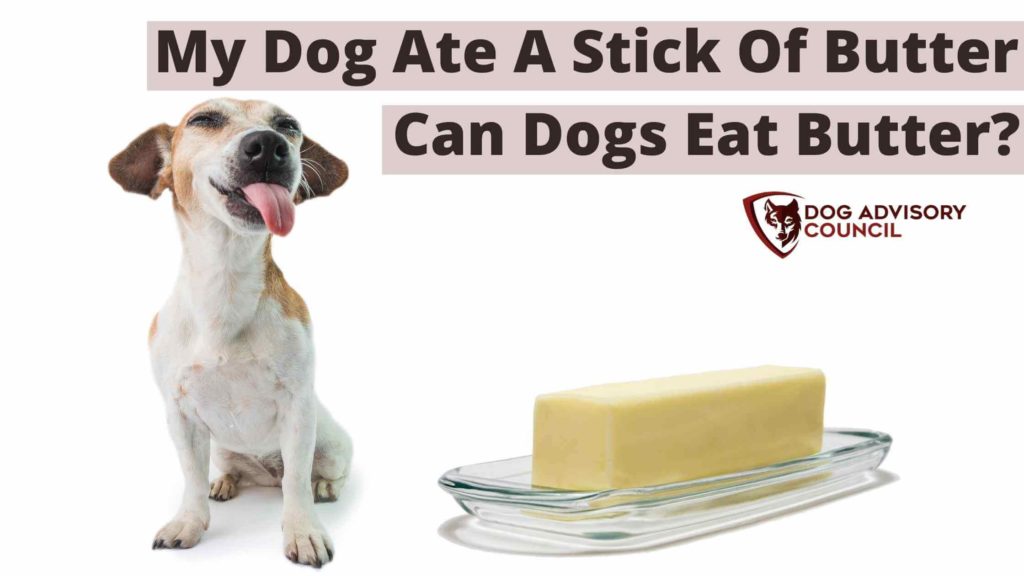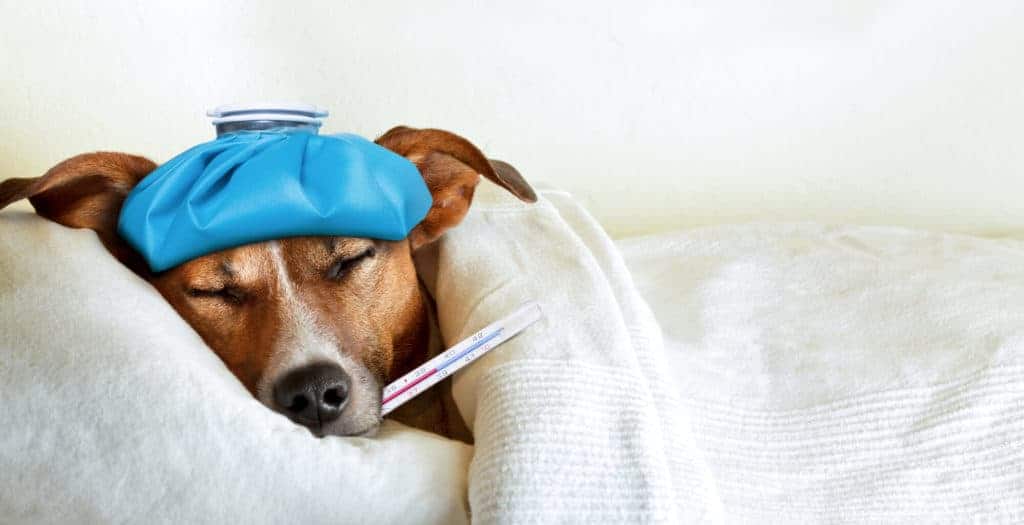
Many of us have had that situation where we’ve put a stick of butter out on the counter for baking, only to turn back to grab it and Fido has run off with it, gobbling as he goes, the bugger! What now? Here are the steps to follow.
Butter is not toxic for dogs, but butter can cause a lot of stomach, and digestive system, problems such as pancreatitis, but it won’t kill your dog. As with eating anything that isn’t recommended, you’ll need to watch for symptoms such as vomiting, stomach pain, and discomfort, and prepare yourself for several serious bouts of diarrhea.
The most important thing to do is keep an eye on him and watch for complications. You may also want to let your vet know what happened just in case, but more on that later.
How dangerous is butter for dogs?
Butter is moderately dangerous for dogs. The actual danger itself comes from the details surrounding the butter (literally and figuratively), all things considered. For instance:
- Was it actual pure butter, margarine or cocoa butter, etc?
- Was the wrapper on or off?
- How much of the stick did he eat?
- Does he have any pre-existing conditions that may worsen his reaction to butter?
We’ll get into these details a little later, but those details are the same ones that your vet will most likely ask, so it’s a good idea to know the answers to them if possible!
How much butter can a dog eat?
Adult dogs should not have more than a teaspoon or two of butter, once or twice a day. This is not only to keep your dog safe but also because there are not many health benefits of too much butter and it can cause pancreatitis in dogs if eaten regularly.
My dog ate a stick of butter: What can happen?
The most likely thing you’re going to notice if your dog eats a butter stick of butter is that he is going to be very uncomfortable. Dogs are lactose intolerant, and real butter has a lot of lactose in it. So, depending on what kind of dog you have, as well as how much he ate, that’s a whole lotta lactose!
He’ll deal with most of the symptoms of lactose intolerance that humans do: bloating, gassiness, indigestion, and that rumbling, chatty sound our stomachs make when they can’t digest something. In several hours, or a day or two, they’ll also deal with diarrhea or — best case scenario — watery poops!
If he’s eaten a significant amount of it (perhaps, a full block), he may also start vomiting. This happens because his body simply can’t tolerate that much lactose (which it isn’t able to digest), so it comes back up once it reaches its capacity. Yuck!
Will a stick of butter hurt a dog?
Assuming he eats pure butter and that it isn’t an entire stick for a tiny dog (ie: he hasn’t eaten half his body weight in butter), then it is relatively harmless for most dogs. He’ll have lactose intolerance symptoms, but this his overall body should be fine. That being, said there are a few exceptions to that. Compilations can occur in the form of:
- Gastroenteritis
- Pancreatitis
- Worsened obesity
Gastroenteritis
In some cases, butter can bring with it new bacteria or virus particles. These are part of the butter itself. Since your dog has eaten a lot of it in a short period, all of that bacteria adds up and can cause gastroenteritis. This causes inflammation in the stomach and intestines and should resolve in a day or two!
Pancreatitis
Common in obese dogs who eat a lot of fatty dog foods, as well as senior dogs, a large amount of butter can also trigger pancreatitis due to the increased fatty substance in a short amount of time. This is when the enzymes in the pancreas start to mistakenly digest the organ itself (eep!) and it is a serious condition that requires a trip to the vet.
In no time at all, however, it can climb from acute to serious pancreatitis and even cause hemorrhaging pancreatitis (when the pancreas ruptures and causes internal bleeding), so this is something that you’ll need to get addressed quickly.
Vets will know when your dog is predisposed to pancreatitis, which is part of why calling your vet to give them a detailed heads-up is a good idea!
Worsened obesity
Just like if we, as humans, ate an entire stick of butter, obesity will also worsen. Since butter is just fat content (not even healthy fat content!), it can worsen a lot of the symptoms that are associated with obesity (such as cholesterol, cardiac problems, etc).

What butter details should I know?
So, now let’s get into that list of questions from up above. Understanding their significance is important to give the vet (and your own records) the accuracy that is needed, after all.
Was it actual pure butter, margarine or cocoa butter, etc?
The reason we’ve been saying “real” butter or “pure” butter is sometimes butter is not actually butter! Sometimes it’s cocoa butter or margarine, for example. These have a completely different make-up than the butter itself.
Cocoa butter is often used by those on diets to replace traditional butter. Since it’s not real butter, it’s “better”…for humans, that is. However, this type of butter has theobromine in it and this is a highly toxic ingredient for dogs. It can cause tremors, seizures, and even heart attacks. To make matters worse, it also contains xylitol, an artificial sweetener, and it’s also very toxic to dogs.
Margarine also has additives, including xylitol, so if he’s eaten “fake butter”, this is cause for concern. Even so, eating just normal butter isn’t always guaranteed safety. Some butter does contain xylitol, too. Reading the label of your butter/margarine, etc because very important, here, since time will be of the essence.
Was the wrapper on or off?
In a lot of cases, the butter wrapper is more dangerous than the butter itself! Since it is made from some sort of foil or plastic, it can be a choking hazard to dogs as he inhales the tasty treat within it. In smaller dogs, the wrapper can cause a blockage in his intestines, which may mean that he is going to need help to pass it through his digestive system.
How much of the stick did he eat?
The amount that he ate also determines how possibly strong any complications will be. The more he ate, the more likely he’ll have some digestive system problems. Likewise, your dog’s size also factors in! The smaller he is, the less it takes to cause a problem!
Does he have any pre-existing conditions that may worsen his reaction to butter?
This refers to conditions such as obesity, diabetes, pancreatitis, or even allergies, as we’ve already covered. Your vet will be the best person to ask for this information, of course!
Can a dog die from eating butter?
Take a breath! In most cases, no, your dog can’t die from eating butter, unless he ate half his body weight. If he’s eaten some sort of butter alternative, however, he can possibly die from the complications of the additive ingredients.
What symptoms should I look for?
The symptoms for butter and butter alternatives are a little different, since their ingredients. Serious symptoms for butter alternatives (most likely containing those dangerous additives) include:
- Shaking and tremors
- Severe disorientation or loss of consciousness
- Excessive distress and/or pain
Some serious complications can pop up from traditional butter, too, especially if he’s eaten the wrapper as well. Some of the serious ones to watch for include:
- Difficulty breathing or panic (the wrapper could be choking him)
- Serious, ongoing vomiting and/or extreme ongoing diarrhea
- Extreme stomach tenderness
If you notice any of these symptoms, you’ll want to immediately take him in to the vet so that they can assess the situation and see just where the problem is.
Is there any kind of butter that’s safe for dogs?
Sure, we all want to give our dog butter, even if just a lick since it’s so delicious, or fill our fridge with only dog-safe butter in case this happens, but there really is no kind of butter that’s safe for dogs. Lactose intolerance makes traditional butter a serious no-no, and any kind of alternative lactose-free butter (including peanut butter) usually contains those dangerous additive ingredients that can kill your dog.
How do I take care of my dog after he’s eaten a stick of butter?
If you’re looking to figure out how to properly care for your dog after he’s eaten your butter, these are the general steps that you can take to keep both him and yourself calm, safe, and as comfortable as possible.
- Don’t give him anything to eat
- Keep them outside or put pee pads down
- Call your vet and let them know and follow all advice they give
- Keep their diet bland and boring for several days
- Watch for serious symptoms
Even the most responsible pet parents make mistakes sometimes, so don’t beat yourself up! The main thing is to be in the know about the potential concerns and dangers surrounding your dog’s annoying butter-eating habit.
In general
No matter how much your dog begs, it is never a good idea to give him any dairy products as they cause stomach and digestive problems more often than not, with certain breeds being more intolerant to lactose.
Of course, we don’t always know how much our pups have eaten when we find them with the butter in their mouth, but that’s why you need to be on the lookout for symptoms, such as vomiting, stomach pain, discomfort, and diarrhea. It may be a good idea to let your vet know what happened just in case!
